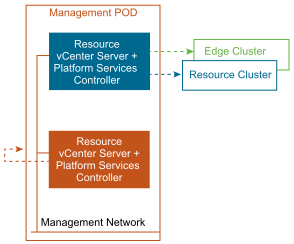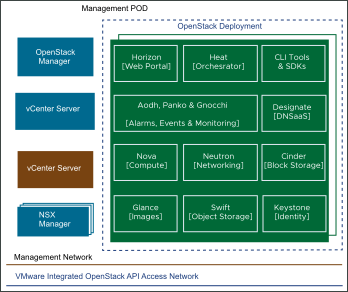The Management Pod contains the components that manage the Telco Cloud Infrastructure OpenStack Edition runtime environment.
vCenter Server
The Management Pod is implemented as a cluster that is managed by the Management vCenter Server instance. The Management Pod hosts the core management domain and all the edge management domains. To form the foundation of a carrier-grade virtualized infrastructure, the components of the Management Pod benefit from the cluster features such as resource management, high availability, and resiliency. A Resource vCenter Server is deployed to oversee the Resource Pods and Edge Resource vCenter Server is deployed to manage Edge sites.
Each vCenter Server instance is a virtual appliance that is deployed with an embedded database. VMware vCenter® Server Appliance™ is preconfigured, hardened, and fast to deploy. The appliance allows for a simplified design, eases management, and reduces administrative efforts. vCenter Server Appliance availability is ensured by using either vSphere High Availability or vCenter High Availability (vCenter HA) cluster, which is realized through three vCenter Server Appliance instances.
The Platform Services Controller contains common infrastructure security services such as VMware vCenter® Single Sign-On, VMware Certificate Authority, licensing, service registration, and certificate management services. The Platform Services Controller handles identity management for administrators and applications that interact with the vSphere platform. The Platform Services Controller can be deployed as a load-balanced pair of appliances per vCenter Server as shown in the following diagram:

Data backup and restore of each vCenter Server instance and its embedded Platform Services Controller is provided by using the native backup service that is built in the appliances. This backup is performed to a separate storage system by using network protocols such as SFTP, HTTPS, and SCP.
VMware NSX-T Data Center
NSX Manager is a management plane component of the NSX-T system. It provides the ability to create, configure, and monitor NSX-T Data Center components, such as segments, gateways, and NSX Edge Nodes.
NSX Manager provides an aggregated system view and centralized network management of NSX-T Data Center. It provides a method for monitoring and troubleshooting workloads that are attached to the virtual networks that NSX-T Data Center creates. NSX-T Data Center provides configuration and orchestration of logical networking components such as segments and gateways, networking services, Edge services, security services, and distributed firewall capabilities.
NSX Manager contains an advanced distributed state management system that controls virtual networks and overlay transport tunnels. NSX Controller is part of the converged NSX Manager appliance and deployed as a three-node highly available cluster, responsible for the programmatic deployment of virtual networks across the entire NSX-T Data Center architecture. The control plane is split into two parts in NSX-T Data Center:
Central Control Plane (CCP) that runs on the NSX Controller cluster nodes. The CCP computes some ephemeral runtime state based on the configuration from the management plane and disseminates information reported through the local control plane by the data plane elements. The CCP is logically separated from all data plane traffic, therefore any failure in the control plane does not affect the existing data plane operations.
Local Control Plane (LCP) that runs on the transport nodes, near the data plane it controls. The LCP monitors local link status, computes most ephemeral runtime state based on updates from the data plane and CCP, and pushes the stateless configuration to forwarding engines. The LCP shares fate with the data plane element that hosts it.
NSX Managers are deployed as a cluster of three manager nodes for high availability with anti-affinity rules configured to ensure that the NSX Managers and the CCP reside on separate hosts to protect against host failures. The LCP shares fate with the data plane element that hosts it, while the CCP inherits the same fate as the NSX Manager in terms of availability. The NSX Manager communicates with Edge clusters over a common management network. The management components of the Telco Cloud Infrastructure platform communicate over the same management network to request network services from the NSX Manager.
VMware Integrated OpenStack
The VMware Integrated OpenStack Manager connects to the vCenter Server instance that manages the Management Pod. It uses a VM template to rapidly deploy, administer, and perform day 2 management operations of the VMware Integrated OpenStack management plane components that are deployed in the Management Pod. After the deployment, VMware Integrated OpenStack connects to the vCenter Server instance that manages the Edge and Resource Pods. This vCenter Server instance is responsible for storage and compute resources. VMware Integrated OpenStack also connects to the NSX Manager instance that is associated with tenant networking.

The VMware Integrated OpenStack management plane features a microservices-based architecture. All the OpenStack services and VMware Integrated OpenStack management services are containerized and managed by Kubernetes. This results in a more lightweight installation, and the control plane requires fewer compute, memory, and network IP address resources. The control plane can be dynamically scaled out, and the number of service instances can be scaled in or out after VMware Integrated OpenStack is deployed. The time required to deploy OpenStack is reduced, and the reconfiguration after any day-2 operation is completed quickly.
All management components have connectivity to each other through a dedicated management network.
VMware Integrated OpenStack is integrated with NSX-T Data Center, providing tenants with enhanced features and capabilities for managing their VNF networking requirements by using the Horizon interface and APIs. Network services include firewalling, network NAT, static and dynamic routing, and load balancing. Tenants can provision Geneve-backed segments for East- West VNF component connectivity and deploy NSX Edges for the North-South traffic as required when connecting to other tenants or to external networks.
It is a best practice that each cluster within Telco Cloud Infrastructure OpenStack Edition is configured to use a shared storage solution. When hosts in a cluster use shared storage, manageability and agility improve.